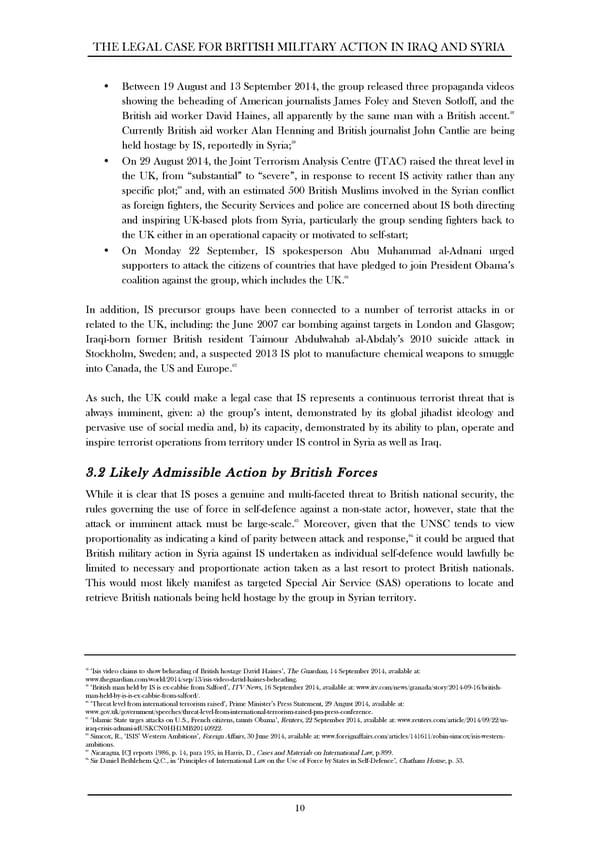THE LEGAL CASE FOR BRITISH MILITARY ACTION IN IRAQ AND SYRIA • Between 19 August and 13 September 2014, the group released three propaganda videos showing the beheading of American journalists James Foley and Steven Sotloff, and the 58 British aid worker David Haines, all apparently by the same man with a British accent. Currently British aid worker Alan Henning and British journalist John Cantlie are being held hostage by IS, reportedly in Syria;59 • On 29 August 2014, the Joint Terrorism Analysis Centre (JTAC) raised the threat level in the UK, from “substantial” to “severe”, in response to recent IS activity rather than any 60 specific plot; and, with an estimated 500 British Muslims involved in the Syrian conflict as foreign fighters, the Security Services and police are concerned about IS both directing and inspiring UK-based plots from Syria, particularly the group sending fighters back to the UK either in an operational capacity or motivated to self-start; • On Monday 22 September, IS spokesperson Abu Muhammad al-Adnani urged supporters to attack the citizens of countries that have pledged to join President Obama’s 61 coalition against the group, which includes the UK. In addition, IS precursor groups have been connected to a number of terrorist attacks in or related to the UK, including: the June 2007 car bombing against targets in London and Glasgow; Iraqi-born former British resident Taimour Abdulwahab al-Abdaly’s 2010 suicide attack in Stockholm, Sweden; and, a suspected 2013 IS plot to manufacture chemical weapons to smuggle into Canada, the US and Europe.62 As such, the UK could make a legal case that IS represents a continuous terrorist threat that is always imminent, given: a) the group’s intent, demonstrated by its global jihadist ideology and pervasive use of social media and, b) its capacity, demonstrated by its ability to plan, operate and inspire terrorist operations from territory under IS control in Syria as well as Iraq. 3.2 Likely Admissible Action by British Forces While it is clear that IS poses a genuine and multi-faceted threat to British national security, the rules governing the use of force in self-defence against a non-state actor, however, state that the 63 attack or imminent attack must be large-scale. Moreover, given that the UNSC tends to view proportionality as indicating a kind of parity between attack and response,64 it could be argued that British military action in Syria against IS undertaken as individual self-defence would lawfully be limited to necessary and proportionate action taken as a last resort to protect British nationals. This would most likely manifest as targeted Special Air Service (SAS) operations to locate and retrieve British nationals being held hostage by the group in Syrian territory. 58 ‘Isis video claims to show beheading of British hostage David Haines’, The Guardian, 14 September 2014, available at: www.theguardian.com/world/2014/sep/13/isis-video-david-haines-beheading. 59 ‘British man held by IS is ex-cabbie from Salford’, ITV News, 16 September 2014, available at: www.itv.com/news/granada/story/2014-09-16/british- man-held-by-is-is-ex-cabbie-from-salford/. 60 ‘Threat level from international terrorism raised’, Prime Minister’s Press Statement, 29 August 2014, available at: www.gov.uk/government/speeches/threat-level-from-international-terrorism-raised-pm-press-conference. 61 ‘Islamic State urges attacks on U.S., French citizens, taunts Obama’, Reuters, 22 September 2014, available at: www.reuters.com/article/2014/09/22/us- iraq-crisis-adnani-idUSKCN0HH1MB20140922. 62 Simcox, R., ‘ISIS’ Western Ambitions’, Foreign Affairs, 30 June 2014, available at: www.foreignaffairs.com/articles/141611/robin-simcox/isis-western- ambitions. 63 Nicaragua, ICJ reports 1986, p. 14, para 195, in Harris, D., Cases and Materials on International Law, p.899. 64 Sir Daniel Bethlehem Q.C., in ‘Principles of International Law on the Use of Force by States in Self-Defence’, Chatham House, p. 53. 10
 The legal case for action Page 9 Page 11
The legal case for action Page 9 Page 11